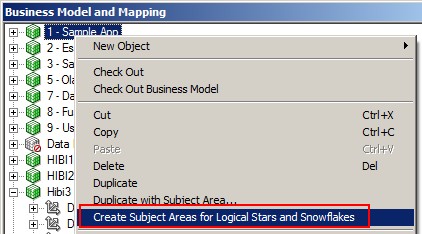About
A subject area in Presentation Service is equivalent to a presentation catalog in BI Server.
In 10g, a difference was made between:
- a subject areas in the Presentation Service
- a presentation catalog in the Presentation Layer
From 11g, no difference in the name is made and this two appellations are regrouped under subject area.
It's also the catalog/metadata that the client tools such as Presentation Service see when they made a connection.
Even though the Logical SQL requests from Answers and other clients query the presentation tables and columns, the real logic for entities, relationships, joins, and so on is in the Business Model and Mapping layer.
The primary function of the Presentation layer is to provide custom names, dictionary entries, organization, and security for different groups of users.
A subject area contains:
- folders,
- presentation tables,
By default, it's created from one logical fact table and it's related dimension.
Articles Related
Multiple subject areas from one business model
Although each subject area must be populated with contents from a single business model, you can create multiple subject areas for one business model. For very large business models, you may want to do this to help users work with the content.
One important reason to use a custom Presentation layer is to make the schema as easy to use and understand as possible. Therefore, users should not be able to view columns that have no meaning to them. The following columns are examples of columns that you might want to remove from the Presentation layer:
- Key columns that have no business meaning
- Columns that users do not need to view (for example, codes, when text descriptions exist)
- Columns that users are not authorized to see
Only for 11g
Users in Oracle BI Answers can create queries that span multiple subject areas, as long as the subject areas correspond to the same business model.
Create Subject Area Function
In the BMM from the version 11g, you can now create automatically the subject area.
In a data warehousing environment
In a data warehousing environment, a subject area is a classification system that represents or distinguishes parts of an organization or areas of knowledge. A data mart is often developed to support a subject area such as sales, marketing, or geography.
Quotes
A consideration to take when designing a subject area is to pay attention at the final user.
Do you design for a user:
- that will use answer to perform ad hoc queries
- or who will interact with the metadata via logical sql, dashboard and prompts.
Best Practices
- Separate each level of a hierarchy in one presentation table
- No more than 11 columns in a presentation table
- Always two identifiers in the name of a column
- Measures by type (Aggregation, Level Based, Time series)
- Only columns that are used logically in the reports
- Only one fact table (one combination of dimension values ie domain)
- Set the Implicit Fact Column (to enable constraints in a dashboard prompt and may be limited choice in the filter wizard).
Security
Privilege
Each subject area have a privilege
Permission
Each subject area have a permission
Master Subject area
A report has only one master subject area. If you want to change it, you need to follow the following steps
Excerpt of an anlytics XML:
subjectArea=""Sales Detail Cube History""
For instance when we have a reports with two subjects area and we want to flip them from: “Old Subject Area Name” to “New Subject Area Name”
- Replace “Old Subject Area Name”.“ by $: X occurrences replace
- Replace (”[\w\s]+“\.”[\w\s-]+“) by “New Subject Area Name”.\1 : Y occurrences replace
- Replace \$([\w\s]+“\.”[\w\s-]+”) by “\1 : X occurrences replaced
- Change the report Subject area to “New Subject Area Name”
